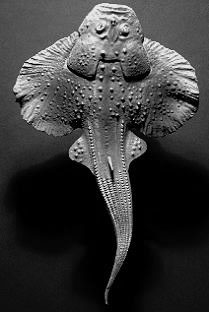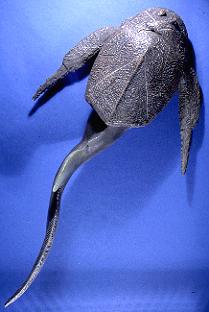As I said Dunkleosteus was not from outer-space but is actually the famous fossil found in the Cleveland shale in Ohio. Many interesting fossils have been found in that locality but Dunkleosteus is definitely a highlight for obvious reasons. Between its fearsome appearance and large size, estimates putting it at 30 feet (10 meters) long and weighing up to 4 tons, it does not fail to arrest our awe and interest.
 |
| One glance of this animals reveals its predatory nature |
 |
| You may have come to the conclusion that this is an Elasmobranch of the skate or ray family but this is actually a Placoderm. It is an example of a benthic organism. |
 |
| Another example of the intriguing diversity of Placoderms. This also was a benthic animal, using its pectoral fins as aids in locomotion. |
 Some scientists have described Dunkleosteus as being an "anguilliform" swimmer. That basically means that Dunkleosteus would have swam like an eel (anguilla is Latin for "eel," form means
exactly what it sounds like). Unfortunately that is a rather
inefficient way of swimming for a pelagic fish that is also a hunter for
it is a slow and clumsy way to go. It works great for eels though. Remember what I said in my last W.P.A. post about scientists and their pessimism? Dunkleosteus though
in my opinion, as well as others' opinions (which are worth more than mine) may
have been a "subcarangiform" swimmer or even a "carangiform" which are
more efficient swimming styles. I wouldn't be surprised if Dunkleosteus would
turn out to be a full "carangiform" swimmer. Being a subcarangiform or a
carangiform swimmer would be more efficient for a predator to be a
predator.
Some scientists have described Dunkleosteus as being an "anguilliform" swimmer. That basically means that Dunkleosteus would have swam like an eel (anguilla is Latin for "eel," form means
exactly what it sounds like). Unfortunately that is a rather
inefficient way of swimming for a pelagic fish that is also a hunter for
it is a slow and clumsy way to go. It works great for eels though. Remember what I said in my last W.P.A. post about scientists and their pessimism? Dunkleosteus though
in my opinion, as well as others' opinions (which are worth more than mine) may
have been a "subcarangiform" swimmer or even a "carangiform" which are
more efficient swimming styles. I wouldn't be surprised if Dunkleosteus would
turn out to be a full "carangiform" swimmer. Being a subcarangiform or a
carangiform swimmer would be more efficient for a predator to be a
predator.
Does that mean that Dunkleosteus was faster than a swimming bullet? Probably not, it was still a very large and heavy animal (you try swimming while wearing heavy armor). Many of the animals that it hunted, however, may have been quite agile. That leads to a rather obvious dilemma. This is probably the cause of Dunkleosteus extinction... Just kidding! As we shall see Dunkleosteus was not without an answer to this problem.
Ascertaining the biomechanics of an extinct animal is a great way to better understand how the animal would have live. Biomechanics is the study of how living organisms operate mechanically. Dunkleosteus is a wonderful example of how biomechanics help us understand an extinct animal. The mechanics of how Dunkleosteus opened its mouth helps us understand how it would have hunted and what it would have hunted. What the biomechanics indicate is that Dunkleosteus may have used suction for capturing prey. Suction feeding is not an uncommon hunting technique in fishes today. As illustrated in the below videos, it a very useful skill for an aquatic predator to have.
OK the first two have scientific interest but, though it is not much for scientific use, I had to add this rather amusing video...
As you can see suction feeding is an effective feeding strategy. A tell-tale characteristic of a suction feeder is the ability to open the mouth very quickly. The speed at which Dunkleosteus has been estimated to open its mouth is between the fastest-suction feeders (like the ones in the videos) and the nurse shark, well within range to be an effective suction feeder. There are soft-tissue morphology that would need to present if Dunkleosteus could have suction fed but the soft tissue is not known in this fish, therefore we can only infer that Dunkleosteus could have suction fed by how the jaws were designed but we will never be 100% confident.
How the jaws of Dunkleosteus worked is very intriguing. There was a gap between the cranium and the thoracic shield which is the body armor behind the head. That gap housed a muscle and muscles can only contract. Take a moment right now and move your arm around. All of those movements that you just did happened because a muscle or a group of muscles contracted. When the muscle that was in that gap between the cranium and thoracic shield of Dunkleosteus, called the nuchal gap, contracted it lifted the upper jaws. There was another muscle that connected the head to the thoracic shield that also assisted with lifting the cranium. The muscles that connected the lower jaw with the bottom of the thoracic shield also contracted at the same time. This caused the mouth to open and based on the size of of those muscles and other factors that would effect performance, it has been estimated that Dunkleosteus could have opened its mouth around 60 milliseconds. This is what is necessary for suction-feeding.
Dunkleosteus may have also had the strongest bite of any fish that has been measured. It has been predicted that the great white shark may have had the strongest bite of any animal alive today but it has never actually been measured. The bite force of Dunkleosteus may have been around 7000 to 6000 newtons. That is a lot of pressure. And the way that Dunkleosteus was designed it would have chomped down at lightning quick speeds, perhaps as fast as it could open its mouth. Crocodylians have the strongest bite force ever measured of an animals alive today at 13000 N (yes you read that right 13,000 N!). Now this is not a post about how AWESOME crocodylians are but consider that the fish that was much bigger than any living crocodile and may have the highest bite force of any fish measured is only around half that of an extant crocodile! Now imagine an extinct crocodylian as big as a school bus! Crocodylians will definitely be a future post for it is not just their bites that are amazing.
OK so back to Dunkleosteus. Now the bite of this fish was around 6000 to 7000 N, hyenas that brake bones with their teeth only have a bite force a little less than 5000 N. The mechanics of their jaws is what helps them achieve such large bite strength. If you have familiarity you with egineering or mechanics, will recognize the mechanical system of Dunkleosteus' jaws as a form of the four-bar linkage system which is a system that is used extensively in both man-made objects as well as in the natural world. Below is a video of how Dunkleosteus' jaw may have worked:
The teeth, or blades rather, of Dunkleosteus was well designed for crushing shells and body armor while cleanly slicing flesh. What that may indicate is that while Dunkleosteus had slicing gear that was effective for crushing animals with body armor such as ammonoids and other placoderms it would have been a very efficient killer of sharks and other soft bodied animals as well. The blades within the mouth of Dunkleosteus allow for a bite that would require as little energy as possible to cleanly brake through hard armor while slicing flesh, basically doing more for less. The strength of its jaws was joined with the design of its blades maximizing its bites effectiveness. This also indicates that it would not swallow prey and its prey may even be quite large making it too big to swallow whole anyways.
Time for some myth-busting. Did you know that you have been misinformed your whole life? That is correct, you have not been told the whole truth about placoderms your entire life. The truth about placoderms is this: they did not have lungs. That is probably earth shattering for you but it is the truth. Next time you hear that bit of mistruth that placoderms did have lungs being repeated then you will now know that it is not accurate. It was a myth started by Robert Denison, then young researcher, in the early 1900s. A more recent look into his description of the specimen that Denison was describing as well as studying the fossils themselves has revealed the mistake. Unfortunately, that was done after the myth was repeated by many mainstream encyclopedias such as the Encyclopedia brittanica and many texts books. Well now you can rest assured that you know the truth about placoderm respiration and now can correct all those you meet so that they too may know that placoderms did not have lungs.
In my opinion this has been an interesting study in the biology and a little ecology of Dunkleosteus. What is interesting is that all that has been revealed about Dunkleosteus has come from studying the anterior part of its body as well as comparing Dunkleosteus with other placoderms. Beyond the head and thoracic shield, no other part of Dunkleosteus has been discovered. Who knows what other interesting facts about this amazing animal we will be to discover if more fossils are found.


No comments:
Post a Comment